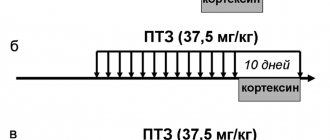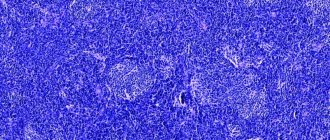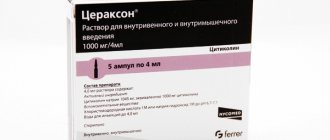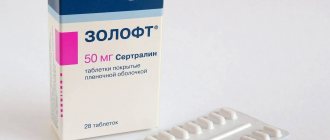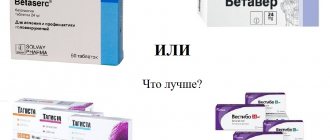Contraindications and unwanted effects
The syrup has relatively few contraindications:
- individual allergic reaction to any of the components of the product;
- congenital fructose intolerance (rare genetic disease);
- vagotonia - tone of the parasympathetic zone of the autonomic nervous system.
Side effects are rare, but still possible in the form of:
- allergies (itching, rash);
- dizziness;
- insomnia;
Sometimes it is difficult for a child to fall asleep after taking the medicine.
- migraine;
- vomiting, diarrhea, nausea, loss of appetite;
- feelings of heat;
- tremor;
- swelling;
- shortness of breath;
- changes in blood pressure (for a short time).
If these symptoms appear, consult your doctor; you may need to change your medication.
Ceraxon solution for intravenous and intramuscular administration 1000 mg, 5 ampoules of 4 ml
Registration Certificate Holder
FERRER INTERNACIONAL (Spain)
Dosage form
Medicine - Ceraxon®
Description
Solution for intravenous and intramuscular administration
- transparent colorless liquid.
1 amp.
citicoline sodium 1045 mg, which corresponds to the content of citicoline 1000 mg
Excipients
: hydrochloric acid 1 M or sodium hydroxide 1 M - up to pH 6.5-7.1, water for injection - up to 4 ml.
4 ml - colorless glass ampoules (5) - contour cell packaging (1) - cardboard packs.
Indications
- acute period of ischemic stroke (as part of complex therapy);
- recovery period of ischemic and hemorrhagic strokes;
- traumatic brain injury, acute (as part of complex therapy) and recovery period;
- cognitive and behavioral disorders in degenerative and vascular diseases of the brain.
Contraindications for use
- pronounced vagotonia (predominance of the tone of the parasympathetic part of the autonomic nervous system);
- children and adolescents under 18 years of age (due to the lack of sufficient clinical data);
- hypersensitivity to the components of the drug.
pharmachologic effect
Nootropic drug. Citicoline, being a precursor of key ultrastructural components of the cell membrane (mainly phospholipids), has a wide spectrum of action: it promotes the restoration of damaged cell membranes, inhibits the action of phospholipases, preventing the excessive formation of free radicals, and also prevents cell death by affecting the mechanisms of apoptosis.
In the acute period of stroke, citicoline reduces the volume of brain tissue damage and improves cholinergic transmission.
In case of traumatic brain injury, it reduces the duration of post-traumatic coma and the severity of neurological symptoms; in addition, citicoline helps to reduce the duration of the recovery period.
In chronic cerebral hypoxia, citicoline is effective in the treatment of cognitive disorders such as memory impairment, lack of initiative, and difficulties in performing daily activities and self-care. Increases the level of attention and consciousness, and also reduces the manifestation of amnesia.
Ceraxon® is effective in the treatment of sensory and motor neurological disorders of degenerative and vascular etiology.
Drug interactions
Citicoline enhances the effects of levodopa.
Ceraxon® should not be prescribed concomitantly with medications containing meclofenoxate.
Dosage regimen
The drug is administered intravenously as a slow injection (over 3-5 minutes, depending on the prescribed dose) or drip infusion (40-60 drops/min). The intravenous route of administration is preferable to the intramuscular route. When administered intramuscularly, repeated administration of the drug in the same place should be avoided.
Acute period of ischemic stroke and traumatic brain injury:
the recommended dose is 1000 mg every 12 hours from the first day after diagnosis; Duration of treatment is at least 6 weeks. 3-5 days after the start of treatment (if swallowing function is not impaired), it is possible to switch to oral forms of the drug Ceraxon®.
Recovery period for ischemic and hemorrhagic strokes, recovery period for traumatic brain injury, cognitive and behavioral disorders in degenerative and vascular diseases of the brain:
The recommended dose is 500-2000 mg/day (5-10 ml 1-2 times/day).
The dose and duration of treatment depend on the severity of the symptoms of the disease. Elderly patients
do not require dose adjustment of Ceraxon® for intravenous or intramuscular administration.
A solution for intravenous and intramuscular administration in an ampoule is intended for single use. After opening the ampoule, the solution should be used immediately. The drug is compatible with all types of intravenous isotonic solutions and dextrose solutions.
Overdose
Due to the low toxicity of the drug, cases of overdose have not been described.
Side effect
Very rare (<1/10,000) (including individual cases):
allergic reactions (rash, skin itching, anaphylactic shock), headache, dizziness, feeling of heat, tremor, nausea, vomiting, diarrhea, hallucinations, swelling, shortness of breath, insomnia, agitation, loss of appetite, numbness in paralyzed limbs, changes in the activity of liver enzymes . In some cases, Ceraxon® can stimulate the parasympathetic system and also cause a short-term change in blood pressure.
If any of the side effects indicated in the instructions get worse, or any other side effects not listed in the instructions are noticed, you should inform your doctor.
special instructions
Impact on the ability to drive vehicles and operate machinery
During the treatment period, patients should be careful when performing potentially hazardous activities that require special attention and speed of psychomotor reactions (including driving a car and other vehicles, working with moving mechanisms, working as a dispatcher and operator).
Storage conditions
The drug should be stored out of the reach of children at a temperature not exceeding 30°C.
Best before date
Shelf life: 3 years.
Use during pregnancy and breastfeeding
Restrictions during pregnancy - With caution. Restrictions when breastfeeding - Contraindicated.
There is insufficient clinical data on the use of citicoline during pregnancy. Although experimental studies on animals have not revealed any negative effects, during pregnancy the drug is prescribed only when the expected benefit of therapy for the mother outweighs the potential risk to the fetus.
If it is necessary to use the drug during lactation, the issue of stopping breastfeeding should be decided, since there is no data on the excretion of citicoline in breast milk.
Use in elderly patients
Restrictions for elderly patients - No restrictions.
Elderly patients
No dose adjustment of Ceraxon® is required.
Use in children
Restrictions for children - Contraindicated. Contraindicated in children and adolescents under 18 years of age.
Terms of sale
The drug is available with a prescription.
Contacts for inquiries
TAKEDA (Japan)
Takeda Pharmaceuticals LLC
119048 Moscow, st. Usacheva, 2, building 1 Business, fl. 5 Tel. Fax E-mail
Features of the use of Ceraxon for the treatment of children
Officially, the medicine is approved only for adults. This is due to insufficient study of the drug. But in practice, Ceraxon for children often becomes a real salvation from many serious disorders of the nervous system, including cerebral palsy.
An increase in the number of perinatal pathologies, complicated or early births - all this leads to an increase in the number of babies at risk of developing pathologies of motor development and speech development delay. It is known that the brain of infants is neuroplastic, that is, timely treatment can prevent developmental disorders of the central nervous system, since the potential for recovery during the newborn period is maximum. Therefore, the effective and non-toxic Cerakson is prescribed to the youngest patients a few weeks old. And, as practice shows, side effects are extremely rare. Usually the medicine is well tolerated even by very young children.
The medicine will help even newborns.
For older children, the medicine is prescribed in the same cases as for adults - for traumatic brain injury or cerebral vascular pathologies. The drug is also recommended when the development of cognitive abilities lags behind the age norm.
The use of Ceraxon leads to children becoming calmer and more adequate, their speech appears or improves, memory and attention improve.
There is no special pediatric form of the drug. The doctor individually selects the dose of Ceraxon for the child depending on his age and the nature of the disease. And, of course, self-medication with such a serious medicine for the purpose, for example, of improving a child’s memory, is unacceptable. Therapy with nootropic drugs is carried out only as prescribed and under the supervision of a physician.
What it consists of and how it works
The main active component of the drug is citicoline, which is produced by the body independently, but in some pathologies the brain needs an additional “portion”. The active substance is absorbed into the gastrointestinal tract and excreted through the respiratory tract and kidneys.
Citicoline has the following effects:
- activates the production of phospholipids (components of cell membranes), which improves ion exchange between neurons (cells of the nervous system);
- increases the stability of cell membranes - as a result, cerebral edema decreases, as a result of which cognitive abilities improve - learning, attention, memory, etc.;
- prevents the appearance of free radicals - compounds that can destroy protective cell membranes;
- improves impulse transmission in the brain;
- reduces the area of brain damage in the acute period of stroke;
- reduces the severity of symptoms of head injuries;
- reduces the time the patient remains in a coma after injury;
- mitigates the effects of cerebral hypoxia.
While taking the medicine, there is an increase in the level of consciousness and an improvement in the patient’s cognitive abilities. But this does not mean that the drug can be taken independently to strengthen memory or, for example, given to a child to eliminate SRD (delayed speech development).
The medicine has quite serious indications, and there are also contraindications, so only a doctor can prescribe it.
In addition to citicoline, Ceraxon also contains excipients. They differ for different release forms - purified water, glycerin, sorbitol, sodium citrate, nipazole, magnesium stearate, castor oil, talc, etc.
